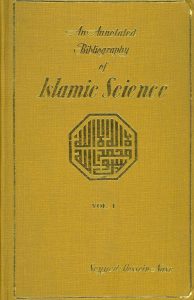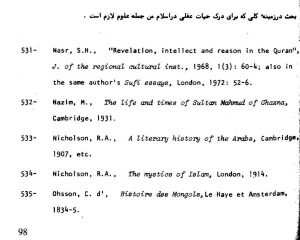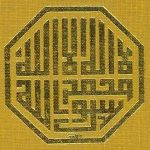An annotated bibliography of Islamic science-Volume I & II – Seyyed Hossein Nasr-Includes bibliographical references and index Publication : Imperial Iranian Academy of Philosophy,1985,Anjuman-i Shahanshahi-i Falsafah-i Iran.; Intisharat-i Anjuman-i Shahanshahi-i Falsafah-i Iran,LCCN: 77-380166
 Prof. Seyyed Hossein Nasr, author of the present bibliography, describes his work in Islamic sciences as a very important component of Islamic civilization and culture, it geographically extends from Spain to eastern Asia and its intellectual activity covers a period of a millennium of human history. Every nation within this spectrum has a distinctive history, culture, wisdom and civilization; hence, the term Islamic Science or Islamic Arts pertains to the unity of all the nations that shared the same religion along with roughly similar social characteristics, in the same period of time. Islamic science, in a vast range of fields as far apart as mysticism and technology, has influenced science and learning in Latin west, in Byzantium, in India and China. Nasr established a research center in Tehran in 1963 in order to prepare the present bibliography that includes all printed works on the history of Islamic sciences in Islamic and non-Islamic languages; however the current work presents only the non-Islamic languages. The project was supported by Franklin publishing house, Pahlavi Foundation and National Iranian Television. The final product is published by the Imperial Iranian Academy of Philosophy in 1975, and another copy is published in Lahore, Pakistan in 1985.
Prof. Seyyed Hossein Nasr, author of the present bibliography, describes his work in Islamic sciences as a very important component of Islamic civilization and culture, it geographically extends from Spain to eastern Asia and its intellectual activity covers a period of a millennium of human history. Every nation within this spectrum has a distinctive history, culture, wisdom and civilization; hence, the term Islamic Science or Islamic Arts pertains to the unity of all the nations that shared the same religion along with roughly similar social characteristics, in the same period of time. Islamic science, in a vast range of fields as far apart as mysticism and technology, has influenced science and learning in Latin west, in Byzantium, in India and China. Nasr established a research center in Tehran in 1963 in order to prepare the present bibliography that includes all printed works on the history of Islamic sciences in Islamic and non-Islamic languages; however the current work presents only the non-Islamic languages. The project was supported by Franklin publishing house, Pahlavi Foundation and National Iranian Television. The final product is published by the Imperial Iranian Academy of Philosophy in 1975, and another copy is published in Lahore, Pakistan in 1985.
Scope
Further, Nasr indicates that determining a precise spectrum for the word “science” had been a challenge; therefore, all branches of philosophy are included except those related to practical philosophy such as ethics, politics, etc. In extreme borderline areas general works are mentioned mainly to give guidelines for further research. Having both Persian and non-Persian scholars in mind, annotation has been given in both English and Persian. Annotations describe the major works and as many of the supplementary materials as was feasible and possible with the limited sources at hand.
The number of entries is a total of 4341 in both volumes, 2770 in volume I, and 1571 more in volume II, which are all alphabetically organized. This volume consists of books, monographs, articles in non-Islamic languages only. Each entry includes, title, author, date and place of publication, and number of volumes and pages in case of an article.

Content
- List of sources; Periodicals, Other collective works
- General works; Bibliography, Manuscripts, Reference works
- Bibliographical works; Subject bibliography, Author bibliography
- General background; Historical, Cultural and Social, Scientific and Intellectual
- Education and Learning
- Bibliographical studies of Muslim men of science
- Author Index
Approach
The author’s approach to classification has considered both the traditional Islamic schemes of classification and the need for an easy retrieval of information as follows: There are 12 main sections of the sciences including: general works, influential forces in creating Islamic sciences, mathematics, astronomy, medicine, etc. Also each section is divided into sub-sections for easier access.
In order to compile the present bibliography, the autho
r has managed to find sources from a variety of periodicals, monographs, encyclopedias, and also the library of Congress, the Bibliotheque National, and the library of Harvard University. A list of non-book sources is assembled and follows the introduction, along with a list of abbreviations. The very last section of this bibliography includes an author index.
To cover all the material listed in the classification, three more volumes will be added to the present two, including Islamic languages in the near future.
